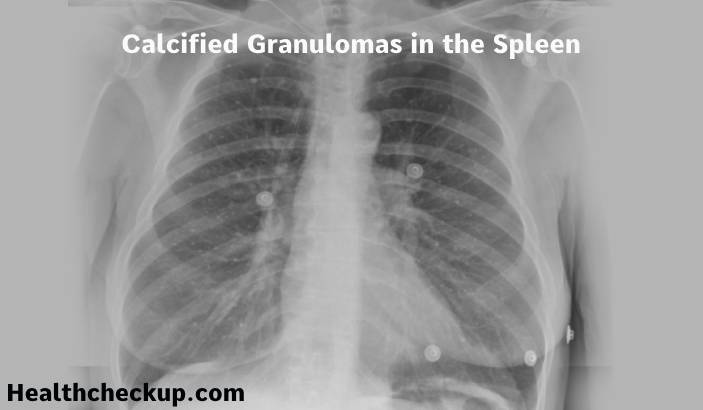Calcified granulomas in the spleen are small, localized areas of inflammation that have undergone calcification. These granulomas are often discovered incidentally during imaging studies for other conditions. While they are usually benign and asymptomatic, understanding their formation, causes, potential implications, and management is crucial for proper medical care.
What Are Calcified Granulomas?
Granulomas are small nodules formed as a result of chronic inflammation. They develop when the immune system attempts to isolate foreign substances that it cannot eliminate, such as bacteria, fungi, or other irritants. Over time, these granulomas can undergo calcification, where calcium deposits form within the tissue, leading to the formation of calcified granulomas.
Formation and Composition
Granulomas are composed of a collection of immune cells, primarily macrophages, which cluster together to wall off the offending agent. Other cells, such as lymphocytes and fibroblasts, also contribute to the granuloma structure. When these granulomas undergo calcification, calcium salts accumulate, making them detectable on radiographic imaging as small, dense areas.
Causes of Calcified Granulomas in the Spleen
Calcified granulomas in the spleen can result from various infectious and non-infectious causes:
- Infectious Causes:
- Tuberculosis (TB): Mycobacterium tuberculosis can lead to the formation of granulomas, which may calcify over time. While TB primarily affects the lungs, it can disseminate to other organs, including the spleen.
- Histoplasmosis: A fungal infection caused by Histoplasma capsulatum, which is prevalent in certain geographic areas. The spores, when inhaled, can lead to granuloma formation in various organs, including the spleen.
- Coccidioidomycosis: Another fungal infection caused by Coccidioides species, found in specific regions like the Southwestern United States. This can also result in granuloma formation and subsequent calcification.
- Brucellosis: A bacterial infection caused by Brucella species, leading to chronic granulomatous inflammation in various organs, including the spleen.
- Non-Infectious Causes:
- Sarcoidosis: An inflammatory disease characterized by the formation of granulomas in multiple organs. The cause of sarcoidosis is unknown, but it can lead to splenic granulomas that calcify.
- Autoimmune Diseases: Conditions such as rheumatoid arthritis or systemic lupus erythematosus (SLE) can cause granuloma formation as part of the immune response.
- Foreign Bodies: In rare cases, the presence of foreign materials in the body can trigger granuloma formation and calcification.
Symptoms and Clinical Presentation
In most cases, calcified granulomas in the spleen are asymptomatic and are discovered incidentally during imaging studies performed for other reasons. However, if symptoms do occur, they include:
- Abdominal Pain: Mild to moderate pain or discomfort in the upper left quadrant of the abdomen, where the spleen is located.
- Fever and Malaise: If the underlying cause is an active infection or inflammatory condition. Splenomegaly: Enlargement of the spleen, which is palpable on physical examination.
Diagnosis
The diagnosis of calcified granulomas in the spleen typically involves imaging studies and, in some cases, additional diagnostic tests:
- Imaging Studies:
- X-rays: Calcified granulomas appear as small, dense, well-defined areas within the spleen.
- Ultrasound: Can detect calcifications and assess the size and structure of the spleen.
- Computed Tomography (CT) Scan: Provides detailed images, allowing for the identification and characterization of calcified granulomas.
- Magnetic Resonance Imaging (MRI): Useful for evaluating soft tissue and can provide detailed images of granulomas and surrounding structures.
- Laboratory Tests:
- Blood Tests: To assess for underlying infections or inflammatory conditions. This includes complete blood count (CBC), erythrocyte sedimentation rate (ESR), C-reactive protein (CRP), and specific serologic tests for infections.
- Microbiological Tests: Cultures or PCR tests to identify infectious agents if an infection is suspected.
- Biopsy:
- In rare cases, a biopsy of the spleen is performed to obtain a tissue sample for histological examination, particularly if the diagnosis is unclear or malignancy is suspected.
Clinical Significance
While calcified granulomas in the spleen are generally benign, their presence can have clinical significance:
- Indicator of Past Infection: Calcified granulomas often indicate a prior, resolved infection, providing insight into the patient’s medical history.
- Differential Diagnosis: Helps differentiate between other splenic lesions, such as tumors or cysts.
- Monitoring Underlying Conditions: In cases where the granulomas are associated with chronic inflammatory or autoimmune diseases, regular monitoring is necessary to manage the underlying condition effectively.
Treatment and Management
Treatment for calcified granulomas in the spleen depends on the underlying cause and the presence of symptoms:
- Observation:
- Asymptomatic Cases: Most calcified granulomas are asymptomatic and do not require treatment. Regular monitoring with periodic imaging studies is recommended to ensure there are no changes in size or appearance.
- Medical Treatment:
- Infectious Causes: If an active infection is identified, appropriate antimicrobial therapy is initiated based on the causative agent. This include antibiotics, antifungals, or antitubercular drugs.
- Inflammatory Conditions: For granulomas associated with conditions like sarcoidosis or autoimmune diseases, treatment involves corticosteroids or immunosuppressive agents to reduce inflammation and manage symptoms.
- Surgical Intervention:
- Rarely Needed: Surgery is rarely required for calcified granulomas unless there are complications such as significant splenomegaly, pain, or suspicion of malignancy. In such cases, splenectomy (removal of the spleen) may be considered.
Calcified granulomas in the spleen are typically benign findings that indicate past or chronic inflammatory processes. While they are often discovered incidentally and not cause symptoms, understanding their potential causes, clinical significance, and appropriate management is essential for providing comprehensive patient care.
I specialize in writing about health, medical conditions, and healthcare, drawing extensively from scientific research. Over the course of my career, I have published widely on topics related to health, medicine, and education. My work has appeared in leading blogs and editorial columns.









